Are you a Quiet Speculation member?
If not, now is a perfect time to join up! Our powerful tools, breaking-news analysis, and exclusive Discord channel will make sure you stay up to date and ahead of the curve.
Treasure Cruise Modern was easily my favorite Modern format of all time---and my addiction to Delver of Secrets is well-documented. Given this, a lot of people have asked me about Bedlam Reveler since it was spoiled. I think it's important to be open to the potential viability of new cards, as being the first to discover a new strategy gives you a leg up on the field. Initially I'll admit I was excited about Reveler's prospects, but my fervor has since cooled somewhat.
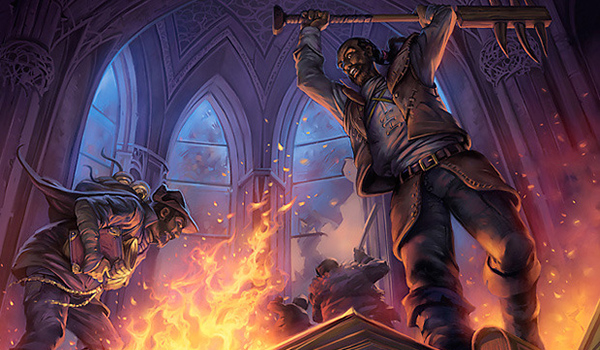
With regard to Bedlam Reveler I started looking at decklists almost immediately, and it didn't take long to feel like R&D was playing with my heartstrings. The first thing that one must realize about the card is that it is much harder to get a discount on than a delve spell. I've cast a lot of turn two Tasigur, the Golden Fang in my day, but doing so is aided by fetchlands. Reveler only counts instants and sorceries and also has a higher base cost. In order to try to turbo-Reveler I started playing with Faithless Looting. It was at this time that I realized things just weren't going to work.
The idea was to be a dedicated Reveler deck. This meant a lot of cheap cantrips: Gitaxian Probe, Thought Scour, Serum Visions, and Faithless Looting. Maybe even some Izzet Charm. Goldfishing that list, it was clear that I was not consistently able to cast Bedlam Reveler on pace where a comparison to Treasure Cruise was anywhere near fair.
I still think Reveler has a place in Modern, but my early dreams of a full-on "Reveler deck" have fallen by the wayside. From working on these lists, here are my findings on Bedlam Reveler.
[wp_ad_camp_1]
A Bad Goryo's Vengeance
After casting some combination of Serum Visions, Faithless Looting, and Thought Scour on turns one and two and not being able to cast Bedlam Reveler on turn three, it occurred to me that there is a deck with most of these elements that could have a Griselbrand in play at this point in the game. 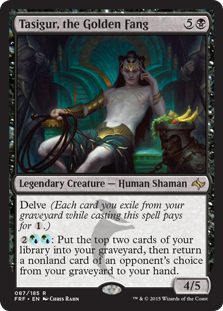 This composition also starts to look at lot like Dredge, which is another deck that is better able to exploit aggressively filling its graveyard. Even outside of those extreme arguments, a Thought Scour into a turn two Tasigur out of Grixis Delver is arguably stronger than most, if not all, early plays from a dedicated Reveler deck.
This composition also starts to look at lot like Dredge, which is another deck that is better able to exploit aggressively filling its graveyard. Even outside of those extreme arguments, a Thought Scour into a turn two Tasigur out of Grixis Delver is arguably stronger than most, if not all, early plays from a dedicated Reveler deck.
The thing is, when you go to the extreme your deck ends up filled with a lot of air, and while "draw three cards" would be a great textbox from here, discarding your hand to do so is far form ideal. Not to mention that a 3/4 prowess is only pretty good in Modern, not exceptional. The primary objective of building a new deck is not to build a worse something else, and dedicated Reveler feels like a worse version of at least two different things. It also provides a unique drawback.
Multiple Revelers in Hand
Bedlam Reveler is your payoff card. The nice thing about is that chaining them together is easy given that it leaves your graveyard behind. So in that respect, you can get to the second Reveler a little easier than the second Cruise. 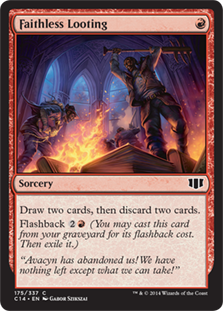 The problem is that keeping a hand with two Revelers is a mulligan. You never want to draw more than one copy at a time, and as such it makes sense to trim on Revelers. That's a problem. Dedicated Reveler distorts your deck significantly for a card that you are incentivized not to play four copies of.
The problem is that keeping a hand with two Revelers is a mulligan. You never want to draw more than one copy at a time, and as such it makes sense to trim on Revelers. That's a problem. Dedicated Reveler distorts your deck significantly for a card that you are incentivized not to play four copies of.
From here the next logical step is to trim on Reveler, and also to trim on the cards that are concessions to being Reveler-heavy. As you move off of Faithless Looting, Reveler becomes more of a plan B, which is not a bad thing to have in Modern. What is problematic though, is that Reveler doesn't necessarily gel well with many plan As. Let's talk about some of these applications, and where they fall short.
Delver of Secrets, BFF?
Delver of Secrets is the most commonly suggested pairing for Bedlam Reveler. The idea is that both Delver and Reveler are looking for a high instant and sorcery density. Theoretically, both cards are trying to play fast games as well, which suggests another degree of synergy. The issue, as stated above, is that Reveler just doesn't come down fast enough. Reveler actually ends up forcing you to play a slightly longer game. In principle I have no problem with that---in fact, my Grixis Delver deck is built for that exact sort of thing. But the cards that help achieve this purpose don't play well with Reveler.
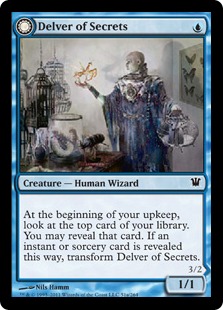 Mana Leak is an essential element of every Delver deck that I've ever built. You will have some opponent playing low-to-the-ground decks where the card doesn't shine and your other cheap interaction will be the heroes---though Mana Leak is the singular card that enables Delver to compete with three- and four-mana spells. Spell Snare is also hugely important, as trading up on mana matters a ton for these lean decks. It also offers the ability to fight attrition wars against Snapcaster Mage, which otherwise leaves these decks dead to rites.
Mana Leak is an essential element of every Delver deck that I've ever built. You will have some opponent playing low-to-the-ground decks where the card doesn't shine and your other cheap interaction will be the heroes---though Mana Leak is the singular card that enables Delver to compete with three- and four-mana spells. Spell Snare is also hugely important, as trading up on mana matters a ton for these lean decks. It also offers the ability to fight attrition wars against Snapcaster Mage, which otherwise leaves these decks dead to rites.
Counters have the same problem with Reveler as redundant Revelers. You will often be forced to discard them. You can technically build a Delver deck that is light on counters or off them entirely, though at this point you're not actually taking advantage of being blue. The UR Delver decks in Legacy play a counter-light burn-heavy strategy, but Modern decks are missing out on both Chain Lightning and, more importantly, Price of Progress. The damage output and modality of most red spells in Modern are too low to reasonably pair them with Delver. Delver does not combine nearly as well with Lava Spike as Goblin Guide does.
Bedlam Reveler Burn
That brings us to an interesting deck that showed up this week. Sam Black posted a video series with a hot take on Bedlam Reveler on Star City Games. Here is the list he used for reference:
Bedlam Reveler Burn, by Sam Black
I can appreciate the angle here. Without going over individual card choices, from a theory perspective this deck looks to do a good job of addressing Burn's problem with running out of gas. Bedlam Reveler can gas back up, and this is a rare version of Burn that can realistically flashback Bump in the Night!
Which brings us to my problem with the core strategy---this deck is too slow. In a field of all Junds, this build seems quite strong. But Modern is full of other decks that are just trying to kill you. With the majority of the spells being non-interactive, this deck simply can't afford to be this slow. If you watch the video, you'll see Sam taking some beatings from Valakut, the Molten Pinnacle. While it is true that Obstinate Baloth is problematic for Burn, Burn's average goldfish is at least a full turn ahead of Valakut's, and the Skullcracks and Atarka's Commands usually found in stock lists make this matchup solidly favorable. Sam's list gives the deck better longevity, but in a way that seriously damages the deck's speed in a format where speed can be everything.
The Takeaway
In a format that is largely about speed and consistency, Bedlam Reveler offers neither. What it does offer is a way to claw back into a game, or to intentionally play a longer game. There are decks in Modern that will put you in positions where this will pay off. In particular, Reveler offers a lot to like against all of the three-color "good stuff" decks of the format. Given the way that Reveler pulls deckbuilding, it makes the most sense as a one- or two-of, and/or as a sideboard option.
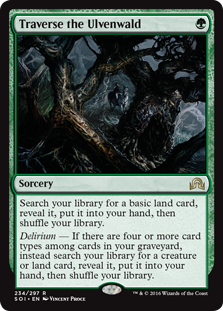 Bedlam Reveler is a card that can win you games in Modern that no other red card could, and I am not trying to posit anything to the contrary. That said, it doesn't line up in a way that contorting your deck significantly to enable Reveler makes sense in Modern. While I don't know how much I approve of the maindeck, I will commend fellow Modern Nexus author Jordan Boisvert on his Reveler management in his latest build of Monkey Grow. Game 1 he has largely conceded a poor attrition matchup, with no Revelers and lots of cards that line up poorly against the interactive decks. This allows him to load up the Revelers and attrition tools in the sideboard and transition for Games 2 and 3. The Traverse the Ulvenwald package in particular is an effective way to avoid overloading on Revelers while maintaining easy access to the card.
Bedlam Reveler is a card that can win you games in Modern that no other red card could, and I am not trying to posit anything to the contrary. That said, it doesn't line up in a way that contorting your deck significantly to enable Reveler makes sense in Modern. While I don't know how much I approve of the maindeck, I will commend fellow Modern Nexus author Jordan Boisvert on his Reveler management in his latest build of Monkey Grow. Game 1 he has largely conceded a poor attrition matchup, with no Revelers and lots of cards that line up poorly against the interactive decks. This allows him to load up the Revelers and attrition tools in the sideboard and transition for Games 2 and 3. The Traverse the Ulvenwald package in particular is an effective way to avoid overloading on Revelers while maintaining easy access to the card.
I see Bedlam Reveler as a player in Modern, though not a flagship card. Reveler generates significant tension in deckbuilding, and doesn't necessarily offer a tool that fits the Modern format at large. At this point in time, I believe that it fits best in the sideboard of red decks. In particular, I like two or three copies in the sideboard of Burn, and could see other low-to-the-ground decks adopting it as a sideboard option or in a small number in the maindeck as well.
When evaluating new cards and strategies, an open mind is a powerful ally. That said, it needs to be backed by a logical process, and good theory. Brew happily, but brew carefully.
Thanks for reading,
Ryan Overturf
@RyanOverdrive on Twitter






Just a thought on reveler:
2-of in U/R Pyromancer Thing? That’s a weird deck, but it made top 8 in Guangzhou
Seems reasonable there. Minimally I like it as a sideboard option for them against Jund, as Jund is quite good at running them out of cards.
Hey Ryan. I’ll post the link to a deck list here, i hope thats ok.
http://tappedout.net/mtg-decks/what-thing-in-the-ice/
I’ve been brewing with reveler since it got spoiled, and this is where i actually got him to work and win games consistently.
You mentioned that UR tempo lists have trouble dealing with midrange threats outside of Mana Leaking them. This deck addresses that by going bigger with Thing in the Ice and bouncing their board.
also note that both Thing and reveler are horrors, so reveler will stay through flips.
The gameplan is turn 1-2 cantrip and/or threat (Thing and Swiftspear). Then Dump your hand of cantrips, bolts and pumps on them to generate value and damage. By turn 4 you have 6 instants/sorceries in your graveyard almost every game (or simply enough to cast reveler), and you reload, leaving you with 3 cards in hand and a powerful board.
When reading articles on Reveler on here, i was wondering when people were going to explore his possible synergy with Thing in the Ice (which is obvious, imo), but it kinda never happened
I’ve done a very simple statistic on my wins/losses with the deck against a number of other decks and am currently winning 2 out of every 3 matches overall (best-of-3s). There have been some insane turn 3 kills in there, and, if left unchecked, turn 4 wins occur pretty frequently. On the other side, I’ve beat jund and grixis midrange with Revelers card advantage more than once.
I’d love to hear your thoughts (and others) on the idea.
One last thing. Ive been considering going Temur for possibly Traverse the Ulvenwald enabling me to drop the Reveler count to 2 and always having access to him, and maybe even Tarmogoyf.
Shoot me a comment, comment on the deck, whatever, I would love to hear your opinion on this.
kind regards
This would be an easier discussion to have in person than over text, though I’ll start by admitting that I haven’t seen quite this angle before. It’s an interesting take, and among the better Reveler lists that I’ve seen. I would not play Shivan Reef, and at most one Sulfur Falls, but that’s minor. My major concern with the deck is that, on its face, it looks like a worse Infect. The deck appears less focused, though arguably comparably explosive and better at interacting. I like that Reveler helps you compete with grindy decks, though I’m not seeing why I would necessarily want that over having Inkmoth Nexus as part of my threat base. I might play with this list, because I will admit that it is intriguing, though I’m not fully convinced at a glance.
Hey Ryan, this isn’t really related but it’s definitely your type of question! I’m sure we’re both excited about Albertus Law’s 1st place finish last weekend. I was wondering specifically about the Young Pyromancers in his deck. I know historically you have been against Pyromancer’s inclusion (I have been also) but in this current meta, chump blockers from Pyromancer seem way better than in the past. Do you have any thoughts on this?
Thanks!
I’m still very against Young Pyromancer, and Gitaxian Probe in particular out of a three-color non-combo deck in Modern does not inspire confidence from me. I think the counterspells are just too important and the Pyromancer and Probes do just too little. Maybe if Reality Smasher didn’t trample.
That makes sense, thanks! I was also wondering what your current Dredge sideboard plan is? I’ve been testing 2x Surgical Extraction in the side to complement the playset of Snapcasters, and I wanted to make sure I got the numbers right, so I created a computer program to crunch the numbers for me. After 40,000 tests, this is what I concluded, with a keepable hand defined as one with at least one land, one Snapcaster, and one Surgical Extraction (obviously there are lots of hands keepable beyond this, but the ability to cast Extraction twice is usually game-winning against Dredge, as it shuts down either their Grave-Trolls and Stinkweed Imps, their discard outlets, or their creatures that return from the grave, depending on the state of the game any of those can crush them.) This is what I found:
1x Surgical Extraction results in about 15.5% keepable hands,
2x Surgical Extraction results in about 28.5% keepable hands,
3x Surgical Extraction results in about 38.0% keepable hands, and
4x Surgical Extraction results in about 45.5% keepable hands.
As you can see, the biggest impact copy is the second, which almost doubles your percentage chance. There’s still an argument for the third copy, but given the premium put on sideboard slots I wouldn’t add it, not to mention the barely noticeable effect of the fourth copy. I think I’m comfortable staying with the two copies, as having 30% of your hands post-board absolutely wreck your opponent seems strong. Keep in mind that out of the other 70%, there is still a decent percentage that can beat Dredge, say with a single Extraction, and a few that just have enough pressure and disruption to beat a slow Dredge draw. Any thoughts on my current Grixis Delver list?
4 Delver of Secrets
4 Snapcaster Mage
3 Tasigur, the Golden Fang
1 Gurmag Angler
4 Serum Visions
4 Lightning Bolt
4 Thought Scour
2 Kolaghan’s Command
4 Mana Leak
2 Terminate
1 Dreadbore
1 Dismember
1 Electrolyze
2 Remand
4 Spell Snare
4 Polluted Delta
4 Scalding Tarn
2 Bloodstained Mire
2 Steam Vents
1 Watery Grave
1 Blood Crypt
2 Island
1 Swamp
1 Mountain
1 Darkslick Shores
2 Ghost Quarter
1 Dispel
1 Grim Lavamancer
2 Magma Spray
2 Surgical Extraction
1 Countersquall
1 Rough // Tumble
1 Bitterblossom
2 Blood Moon
1 Painful Truths
1 Shatterstorm
I guess I’ve been rambling for a while now. I’ll stop
My plan for Dredge is to either pack four Leylines or to let the field do the work. Two cards that are just for Dredge are low percentage enough with the matchup being bad enough that I don’t think they’re worth it. Just don’t get paired against the deck with your tournament life on the line.
Your maindeck is fine. I haven’t been impressed with the second K Command with Grixis mirrors not being very popular currently, but it plays. I don’t like Dreadbore as I both plan to counter Nahiri and would rather have Hero’s Downfall against a resolved one as it can also hit Collonade.
For the sideboard, I don’t care for Blood Moon in general, and I think Blood Moon plus Ghost Quarter is oversideboarding for that sort of effect. In particular, you’re shy on Countersqualls, which may be the best card in the sideboard. Rough//Tumble doesn’t seem worth a slot at all, as you can beat Elves by just casting one for ones and Snapcasting them. I like spells over Lavamancer, Shatterstorm is slow and unnecessary, and while I get Bitterblossom I think one copy is just kind of weird. Would rather play more generic stuff.
I can see why you would want to just concede the Dredge matchup, however, I personally don’t like not having at least a decent chance against all tier 1 decks, and of courses Surgical Extraction is decent to great against a variety of other decks as well.
As for Dreadbore vs. Hero’s Downfall, I have found that the one mana discount is a major improvement in most matchups. Keep in mind that although Nahiri is the reason the card is in the deck, I also will draw it against lots of faster decks so I would like it to be playable there, where a 1 turn delay could mean the game. I also have found that double black is a lot harder than red black. I concede that Hero’s Downfall is better against Jeskai, but since it’s maindeck I’d rather run the more flexible choice. Just playing an extra Terminate is always an option too, I suppose.
That particular sideboard was a little messy for sure. Blood Moon does seem better to me than Ghost Quarter, and my main reason for including it was to have better game against Bant Eldrazi, which continues to pick up in popularity. Do you think that matchup is good? I’ve struggled to beat any Cavern of Souls draw, which I suppose could be Ghost Quartered but Blood Moon is obviously better in that matchup, while also wrecking midrange and land based strategies.I agree that Rough//Tumble isn’t that strong and that Countersquall is one of my best options. Do you not like Shatterstorm because you think Affinity is already a good matchup? As for Bitterblossom, I’ve been playing with a singleton copy in my sideboard for forever and it has always been great, I think I’ll leave that one alone
Way to steal my article name from a month ago (:
http://www.5colorcombo.com/emn/2016/07/22/bedlam-reveler.html
Given the volume of content sites out there now, this sort of thing is bound to happen. Never heard of that one. Not to mention that if I wanted the title to be “Bedlam Reveler Sucks”.
HI Ryan, thanks for the article. I’m very happy that Nexus has such a dedicated crowd of tempo writers, given the relative lack of prevalence of the playstyle in the current Modern tier 1 metagame. I’m curious about whether or not you’ve tried to incorporate a Disrupting Shoal shell into Grixis Delver using maindeck Reveler.
So far in my own testing I’ve found that in Grixis, as generally opposed to the Temur Delver Shoal list that Jordan Boisvert has been developing, I’m much more comfortable playing my deck’s best spells proactively (Bolt, Terminate, KCommand)) and emptying my hand trading cards with the opponent, which plays well with Reveler’s requirements.
I understand the hesitation to move away from the established Grixis Delve shell that has done well, but trading out Tasigurs and Anglers for maindeck Revelers and a few Vendilion Cliques has done very well for me when I also play Disrupting Shoal. This shift comes with a few different moves that I find are also relevant. Trading Thought Scour for Gitaxian Probe is important, as another free spell to get to your Revelers faster. Shoal also helps with this, and while there are certainly strong arguments against 2 for 1’ing yourself, filling the yard with more instants/sorceries for free and either retaking tempo or definitively stopping your opponent from gaining tempo has made Shoal a key roleplayer for me and substantially mitigated the situations where I need to pitch relevant cards when Reveler etbs.
I’d love to hear your thoughts on this kind of configuration, and I’d be happy to post the decklist I’ve been working with or talk more in depth here or via PM.
I disagree that Grixis Delver is about trading aggressively, and I find most of my losses have been because I didn’t display enough patience with my interactive spells. More often than not, I find myself two or more cards up on cards in hand over my opponent, and I believe that to be the deck’s primary strength, so I neither understand where you’re coming from or why you would move the deck in the other direction. If your shell is working for you, that’s awesome, though from how I play and understand the deck, I would not be interested in Shoals.
Understood :). My experiences with tempo in Modern and with Grixis have generally led me to favor as proactive an approach as possible with the limited exceptions of combo decks such as Scapeshift, where an answer will always be immediately required or else you lose the game. I suppose there is an argument that the “Gotcha!” decks also have something of this element to them, but both Temur and Grixis decks have plenty of interaction to deal with those decks, and I haven’t often felt the pressure to play differently. I’m pleased to see that the archetype can favor both the aggro and the control in this aggro-control deck.
Hey Ryan, this is a bit off-topic, but after the Modern GP weekend would you have any updates for your Grixis Delver list? I know you don’t think reveler or pyromancer really have a place, but how do you think blood moon works in the sideboard?
The maindeck is constructed in a way that tries to force interactive games of Magic, which most Modern opponents won’t be ready for. Blood Moon is a gotcha card, and doesn’t fit here. I don’t endorse it, but others play with them. I think it is both narrow and an odd fit.